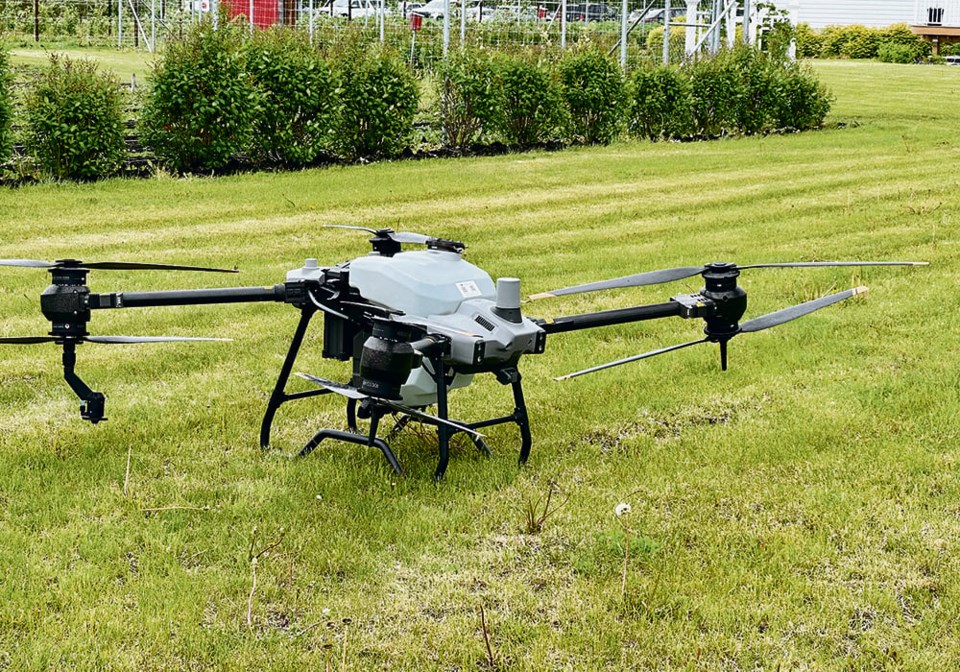SASKATOON — The ray of hope might be dim right now, but farmers wanting to legally spray pesticides on their crops using drones may be seeing the first hint of light at the end of the tunnel.
Ross Breckels, a senior scientific evaluator with Health Canada’s Pest Management Regulatory Agency (PMRA), said the process of getting common pesticides “on-label” for use by drone is coming along faster than he expected a year ago.
Four requirements must be satisfied before the agency makes an on-label decision for a pesticide and, in this case, its method of application. Those include drift risk, efficacy, maximum residue limits and impacts of operator and bystander exposure. It’s up to chemical companies to submit pesticides for on-label drone use and make a case for their safety, Canadian authorities have said.
Some — including Breckels — previously suggested there hasn’t been a lot of activity in that domain.
He’s more optimistic today, thanks to research being conducted around the world.
Perhaps the biggest example of that work is the Unmanned Aerial Pesticide Application System Task Force. That’s a group of eight agricultural chemical companies generating drone-spraying data on off-site movement, operator/handler exposure and human dietary exposure for regulatory authorities around the world. The task force has an annual multimillion-dollar budget.
Breckels takes the number of zeros in that figure as a sign that major chemical companies are taking the file seriously.
“It’s not an insignificant amount of money that they’re putting into this. So, obviously there is a lot of interest from chemical registrants,” he said.
Companies involved in that initiative include BASF, Bayer CropScience, Corteva Agriscience, FMC, Gowan, NuFarm, Syngenta and Valent.
Results coming out of the task force might mean good news for farmers hoping to use drones for pesticide application, said Breckels.
“They have been conducting worldwide drift trials in 2023 and some are still ongoing in 2024. They are going to submit their data to the PMRA sometime this fall as well.”
Breckels also pointed to a presentation at the American Chemical Society conference in August, which hinted at “encouraging” preliminary results from residue trials.
“They’re hopefully going to provide the PMRA with the data from those results in the coming months.”
To date, only four chemical products have received PMRA approval for drone application — none directly related to agriculture. Garlon XRT herbicide was approved for industrial use this summer, while the others are larvicides for mosquito control.
This effectively makes the spraying of any ag pesticide by drone illegal, with fines up to $10,000.
Drones have their share of advocates and skeptics. In an interview earlier this year, spray expert Tom Wolf cautioned that their smaller tanks and lower water volumes translate to very fine spray droplets, which have more risk of going off-target.
Markus Weber — a central Alberta drone salesperson and instructor — does not agree with that assessment. He cited leading spray drone manufacturers such as DJI, XAG and Hylio that are already manufacturing drones capable of adjusting droplet size.
“A drone operator is able to change droplet size from as low as 50 or 100 microns — extremely drift-prone droplets but in some cases necessary, say, for an orchard where you’re trying to penetrate a canopy for insect control. In those cases, some really fine droplets are called for.
“And then, in situations where you have higher winds and you need to control drift in more of a typical Western Canada field scenario, then the larger droplet size makes sense, and that one tool lets you do all of that.”
Weber says the first ag products approved for drones will likely be fungicides and chemicals for various niche uses.
“That’s been proven true with Garlon XRT,” he said.
How popular spray drones will be once common ag pesticides are registered is another matter, said Breckels, adding they won’t likely replace ground sprayers or manned aircraft as application methods.
“They’ll work in conjunction with them, so the pesticide companies would still get their revenue from field sprayers and air applicators.”
Related
Chinese-made agriculture drones labelled security risk
VIDEO: Study seeks more information on pod shatter resistance
Bayer launches VT4PRO at Canada’s Outdoor Farm Show 2024
Corteva showcases new BMR silage varieties at Canada's Outdoor Farm Show
Biologicals business receives funding boost
About the author




